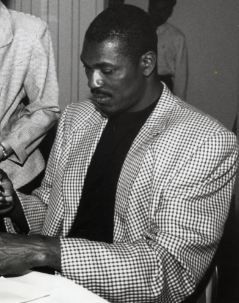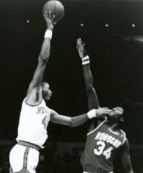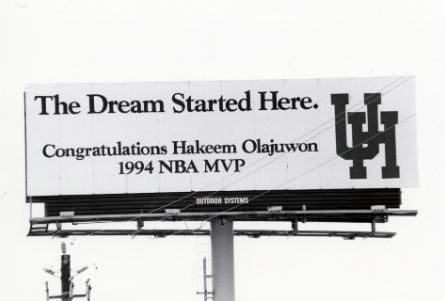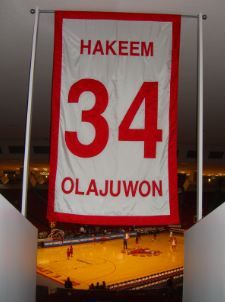Hakeem Abdul Olajuwon is a Nigerian-American basketball player that grazed the National Basketball Association’s courts between 1984 to 2002. Renowned as “The Dream,” he cemented himself as one of the league’s top-notch players not only of his era but in the entire NBA, thanks to his distinct playing style, blending strategical defensive skills with swift offensive prowess. In this article, let’s know more about Hakeen Olajuwon’s life and his journey and success in the world of basketball.
Early Life and Collegiate Career
On January 21, 19633, Hakeem Olajuwon in Lagos, Nigeria. His Yoruba parents are Salim and Abike Olajuwon, owners of a cement business, that played their duty of inculcating the principles of discipline, hard work, honesty, and respect to him and his seven siblings.
During childhood, Olajuwon was actually a soccer goalkeeper throughout his childhood and early teenage years. Nevertheless, it has been instrumental in teaching him agility, balance, and footwork, given that he stands 7-foot (2.13-metre).
It was only at the age of 15 and in high school when started playing basketball. After two years of learning the sport, he emigrated from Nigeria to the United States as he was recruited to play for the University of Houston. In his first playing season, the team made it to the final four in the 1982 National Collegiate Athletic Association (NCAA) tournament.
The following year, Houston made it to the Finals, with Olajuwon being named as the Most Oustanding Player. However, it went for naught, as the team lost to North Carolina State University in an upset. They returned to the Finals in 1984 but fell short once more against Georgetown University.
Houston Rockets
After the 1983-84 NCAA season, Olajuwon decided to join the NBA draft. He was selected by the Houston Rockets and became the top pick in the 1984 NBA draft, ahead of other stars, such as Charles Barkley, John Stockton, and Michael Jordan.
In his first season with the Houston Rockets, Olajuwon ranked second place in the Rookie of the Year, lagging behind the 1984 Rookie of the Year winner and his teammate, Ralph Samson. Together, they helped the Rockets reached the playoffs. The following year, Olajuwon led the team to the NBA Finals but lost to the Boston Celtics.
In the 1987-88 season, Samson’s knee injury started, which eventually ended his NBA career. The Rockets’ performance dwindled only reaching beyond the first once in five years, from 1987 to 1992.
Nevertheless, Olajuwon continued to display remarkable individual play, making him the Rocket’s franchise player. He also developed his signature move called “Dream Shake,” characterized by a series of spins, feints, and drop steps that Olajuwon would do near the basket, leaving his opponents perplexed, while giving him a free shot.
Though the 1989-90 season was another bad year for the Rockets, Olajuwon became the league’s leader in rebounds and became one of the three NBA players to register a quadruple-double performance.
The 1991 and 1992 season was no different with the team showing dismal outings. With that, Olajuwon asked for a trade, pointing to unsatisfactory performance and contract issues, causing him to be nearly released before the 1992–93 season.
The Rise of the Houston Rockets
The Rockets started with a new coach, Rudy Tomjanovich, whilst Olajuwon improved his performance. He set a new career-high of 3.5 assists and 26.1 per game and finished as the runner-up in the MVP race, behind the winner, Charles Barkley. Olajuwon’s contract was extended for another four years. It was a perfect time as he was entering his prime, and the team has also established a solid core of young players and veterans behind his leadership.
Olajuwon’s career peaked in the 1993-1994 season, as he led the Houston Rockets to the NBA Finals against New York Knicks, which was then led by his collegiate rival, Patrick Ewing. The series was stretched to Game 7. Olajuwon’s heroics helped the Rockets overcome the Knicks, averaging 26.9 points per game, with a 50% shooting percentage, and leading Houston to their first NBA Championship win.
In that season, Olajuwon was, indeed, on the pinnacle of his career, becoming the first NBA player to be awarded the “Defensive Player of the Season,” “MVP,” and “Finals MVP,” all in the same season. Riding on their momentum, the Rockets swept the Orlando Magic in the NBA Finals the following season, was again named Finals MVP.
The Fadeaway
Whilst Olajuwon continued to display remarkable performance, Michael Jordan’s return from an 18-month hiatus prevented to Rockets to get another shot at the Championship. In the last years of the 1990s, Olajuwon started to shy away from the limelight with his point production dipping.
In 2001, he refused a $13 million deal with Houston and was traded to Toronto. He only played one season with the Raptors, before retiring the following year due to a back injury. Shortly after, Olajuwon’s #34 jersey was retired by the Houston Rockets.
During his retirement, 12-time All-Star Hakeem Olauwon’s was 7th in career points, recording a total of 26,946, and 11th in career rebound, registering 13,748. In 2008, he was elected into the Naismith Memorial Basketball Hall of Fame.





